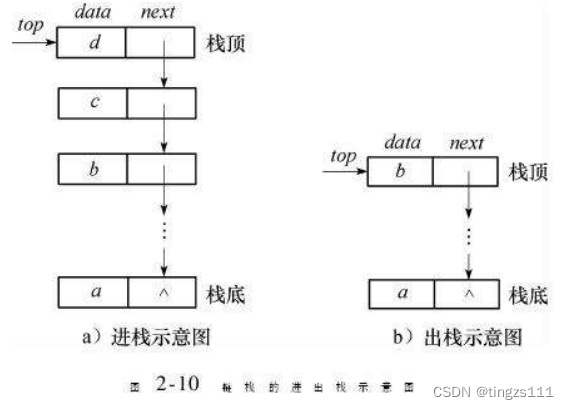目录
1.栈
1.1 栈的概念及其结构
栈:是一种特殊的线性表,只允许在固定的一端进行插入和删除元素,这一段称为栈顶,另一端称为栈底,栈中的元素遵循先进后出的原则
1.2 栈的实现
栈的实现一般是使用数组或者链表实现,先比较而言,数组实现的结构更简单一些,因为数组在尾上插入数据的代价更小。

#pragma once
#include<stdio.h>
#include<stdlib.h>
#include<assert.h>
#include<stdbool.h>
typedef int STDataType;
//动态的栈,静态的栈去掉capacity
typedef struct Stack
{
STDataType* a;
int top;//标识栈顶的位置
int capacity;
}ST;
void StackInit(ST* ps);//初始化
void StackDestory(ST* ps);//摧毁
void StackPush(ST* ps,STDataType X);//插入
void StackPop(ST* ps);//删除
STDataType StackTop(ST* ps);//取栈顶元素
int StackSize(ST* ps);//计算栈的元素个数
bool StackEmpty(ST* ps);//判断栈为不为空
栈的实现
#include"Stack.h"
void StackInit(ST* ps)
{
assert(ps);
ps->a = NULL;
ps->top = 0;
ps->capacity = 0;
}
void StackDestory(ST* ps)//删除栈
{
assert(ps);
free(ps->a);
ps->capacity = ps->top = 0;
}
void StackPush(ST* ps, STDataType X)//插入
{
assert(ps);
if (ps->top == ps->capacity)
{
int newcapacity = ps->capacity == 0 ? 4 : ps->capacity * 2;
STDataType* tmp = (STDataType*)realloc(ps->a, sizeof(STDataType)*newcapacity);
if (tmp == NULL)
{
printf("realloc fail\n");
exit(-1);
}
ps->a = tmp;
ps->capacity = newcapacity;
}
ps->a[ps->top] = X;
ps->top++;
}
void StackPop(ST* ps)//删除
{
assert(ps);
assert(ps->top >= 0);
//assert(!StackEmpty(ps));
ps->top--;
}
STDataType StackTop(ST* ps)//取栈顶元素
{
assert(ps);
assert(ps->top >= 0);
//assert(!StackEmpty(ps));
return ps->a[ps->top - 1];
}
int StackSize(ST* ps)//计算栈的元素个数
{
assert(ps);
return ps->top;
}
bool StackEmpty(ST* ps)//判断栈为不为空
{
assert(ps);
return ps->top == 0;
}2.队列
2.1 队列的概念及结构
队列:只允许在一段进行插入数据操作,在另一端进行数据删除的特殊线性表,其具有先进先出的特性,进行插入操作的一端是队尾,进行删除操作的一段叫做队头
2.2队列的实现
队列也是可以用数组和链表来实现的,但是队列使用链表更优一些,因为在出队的时候,比数组效率高。
队列实现的.h
#pragma once
#include<stdio.h>
#include<stdlib.h>
#include<assert.h>
#include<stdbool.h>
typedef int QDataType;
typedef struct QueueNode
{
QDataType data;
struct QueueNode* next;
}QNode;
typedef struct Queue
{
QNode* head;
QNode* tail;
}Queue;
void QueueInit(Queue* pq);
void QueueDestroy(Queue* pq);
void QueuePush(Queue* pq, QDataType x);
void QueuePop(Queue* pq);
QDataType QueueFront(Queue* pq);//取队头的数据
QDataType QueueBack(Queue* pq);//取队尾的数据
bool QueueEmpty(Queue* pq);//判断队列是否为空
int QueueSize(Queue* pq);队列实现
#include"Queue.h"
void QueueInit(Queue* pq)
{
assert(pq);
pq->head = pq->tail = NULL;
}
void QueueDestroy(Queue* pq)//摧毁队列,释放队列
{
assert(pq);
QNode* cur = pq->head;
while (cur)
{
QNode* next = cur->next;
free(cur);
cur = next;
}
}
void QueuePush(Queue* pq, QDataType x)
{
assert(pq);
QNode* newnode = (QNode*)malloc(sizeof(QNode));
if (newnode == NULL)
{
printf("malloc fail\n");
exit(-1);
}
newnode->data = x;
newnode->next = NULL;
if (pq->head == NULL)
{
pq->head = pq->tail = newnode;
}
else
{
pq->tail->next = newnode;
pq->tail = newnode;
}
}
void QueuePop(Queue* pq)
{
assert(pq);
assert(!QueueEmpty(pq));
if (pq->head->next == NULL)
{
free(pq->head);
pq->head = pq->tail = NULL;
}
else
{
QNode* next = pq->head->next;
pq->head = next;
}
}
QDataType QueueFront(Queue* pq)//取队头的数据
{
assert(pq);
assert(!QueueEmpty(pq));
return pq->head->data;
}
QDataType QueueBack(Queue* pq)//取队尾的数据
{
assert(pq);
assert(!QueueEmpty(pq));
return pq->tail->data;
}
bool QueueEmpty(Queue* pq)//判断队列是否为空
{
assert(pq);
return pq->head == NULL;
}
int QueueSize(Queue* pq)
{
assert(pq);
int size = 0;
QNode* cur = pq->head;
while (cur)
{
cur = cur->next;
size++;
}
return size;
}






















 4724
4724











 被折叠的 条评论
为什么被折叠?
被折叠的 条评论
为什么被折叠?








